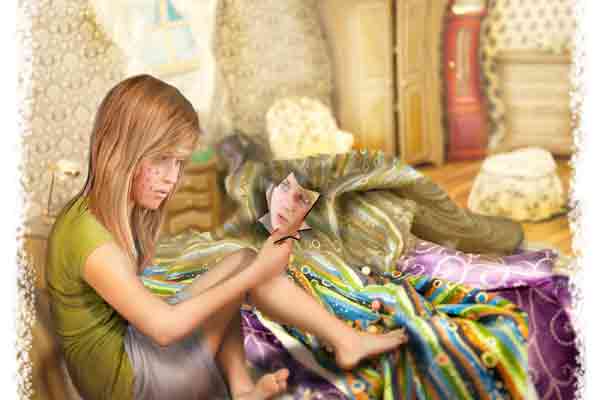

One of Chiara Coccorese’s illustrations for The Broken Mirror. Illustration: Chiara Coccorese
London, UK (BBN) - This year marks the 350th anniversary of Jonathan Swift’s birth, which makes it a good moment to reflect on the many paradoxes of his art.
In an age when it has become the purest cliche to point out that modern political reality outstrips the efforts of the satirist at every turn, it’s gratifying to return to the greatest of all satires in English, Gulliver’s Travels – a book that owes its longevity, among other things, to its generic ambiguities, reports The Guardian.
For almost three centuries it has been revered both as a harrowing critique of politics, society and human nature and as a children’s fantasy adventure.
It was partly to immerse myself in these ambiguities that I accepted a commission, a few years ago, to write an abridged version of Gulliver’s Travels, this time targeted specifically at young children.
The initiative came from the Italian writer Alessandro Baricco, who had the idea of commissioning a number of writers (Umberto Eco and Ali Smith were among the others) to produce children’s versions of literary classics for a series called “Save the Story”.
I worked for several weeks trying to distil the essence of Swift’s original, to preserve the delicate blend of political moralising and ludic fantasy that made him declare it was written “to vex the world rather than divert it”. At the end of the process, I was seized with the desire to attempt something generically similar, albeit of far smaller scope and ambition.
Where to start? My mind went back to a children’s book I had tried to write in 1983, in the long summer vacation between my stints at Cambridge and Warwick universities. Like many authors, I have a stash of unpublished manuscripts in a bottom drawer, and sometimes I cling to the idea that they might be worth exhuming.
Of course, they never are. On a reread it turned out that this one – about the adventures of four children who discover a fragment of broken mirror that reflects an alternative world – began promisingly enough before degenerating into a flagrant Narnia rip-off. It was doubly disappointing, because the initial premise seemed good. Could I make something out of that simple idea?
Simplicity: another area in which Swift could be an inspiration. Not the simplicity of his irony, of course (which has proved to be multi-layered and complex enough to keep scholars arguing over his real meanings for centuries) but the plainness of his diction: another reason, surely, why Gulliver’s Travels has had such appeal as a children’s book over the years. I’d tried to match that plainness in my abridgement, helped by the knowledge that it would immediately be translated into Italian: you tend to keep verbal ornaments to a minimum when you know that what you’re writing is not going to be read in the original language.
So, a few things were now becoming clear: The Broken Mirror would be a fantasy story based on a simple premise. It would be for children and adults alike, would have a political undercurrent, and I would write it initially for publication in Italian, not English. Then I started to think about enlisting the help of an illustrator, and the Italian connection became even stronger.
Chiara Coccorese is an artist based in Naples, where I met her at a literary festival in 2007. Naples was having a serious problem with refuse collection, which was under the control of the Camorra.
Rubbish was piling up in the streets, and Chiara had responded with a series of paintings showing idealised scenes from fairytales with added piles of incongruous rubbish.
I loved the playful social comment in these pictures, but most of all I loved the vivid colours, her baroque sensibility and commitment to intricate, meticulous levels of detail. (In addition to her own work, she also restores frescoes.) There were strong echoes of Lewis Carroll and Arthur Rackham in her work as well. She agreed to provide a dozen illustrations for my story and what followed was a true collaboration.
By the time I came to prepare the manuscript for a UK publisher, it was four years after Italian publication: the world had changed, and my feelings about the book had changed too.
Populism was on the rise, the British had voted for Brexit, Trump was US president.
The world seemed a darker and more threatening place, and I took the opportunity to make sweeping revisions, rewriting five of the 10 chapters completely.
The new British edition is less benign and sunny than the Italian original, though it ends on the same note of questioning optimism.
The book is a fable about a girl’s developing political awareness. Fables are by their nature didactic, but personally, as a child, I was never put off by didacticism in fiction. I spotted the Christian allegory in the Narnia books right away and was fascinated by it, although it never made me a Christian. The Broken Mirror operates in that tradition too, and for some that will make it an old-fashioned book.
I wrote it, in part, out of nostalgia for the books I read when I was nine or 10 (Stig of the Dump is another influence). But perhaps this does, paradoxically, give it a contemporary feel. It finally lands in Britain at a time when a hankering for 1950s-style social conservatism is opposed by the offer of a return to 1970s-style socialism. Maybe, whether we like it or not, we are all nostalgics now.
BBN/MMI/ANS